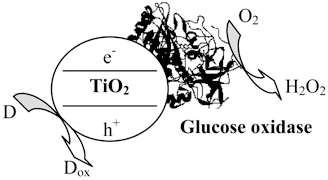Glucose oxidase catalyses the reduction of O2 to H2O2 in the presence of irradiated TiO2 and isopropyl alcohol
Abstract
Catalytic amounts of

* Corresponding authors
a
Dipartimento di Chimica, Università di Sassari, Via Vienna 2, 07100 Sassari, Italy
E-mail:
billia@ssmain.uniss.it
b Dipartimento di Chimica , Università di Ferrara, ISOF C.N.R Sezione di Ferrara, Via L. Borsari 46, 44100 Ferrara, Italy
Catalytic amounts of

 Please wait while we load your content...
Something went wrong. Try again?
Please wait while we load your content...
Something went wrong. Try again?
M. L. Ganadu, L. Andreotti, I. Vitali, A. Maldotti, A. Molinari and G. M. Mura, Photochem. Photobiol. Sci., 2002, 1, 951 DOI: 10.1039/B109953C
To request permission to reproduce material from this article, please go to the Copyright Clearance Center request page.
If you are an author contributing to an RSC publication, you do not need to request permission provided correct acknowledgement is given.
If you are the author of this article, you do not need to request permission to reproduce figures and diagrams provided correct acknowledgement is given. If you want to reproduce the whole article in a third-party publication (excluding your thesis/dissertation for which permission is not required) please go to the Copyright Clearance Center request page.
Read more about how to correctly acknowledge RSC content.
 Fetching data from CrossRef.
Fetching data from CrossRef.
This may take some time to load.
Loading related content
